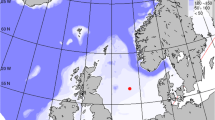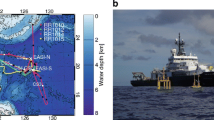Abstract
The spatial structure of the wave field during hurricane conditions is studied using the National Data Buoy Center directional wave buoy data set from the Caribbean Sea and the Gulf of Mexico. The buoy information, comprising the directional wave spectra during the passage of several hurricanes, was referenced to the center of the hurricane using the path of the hurricane, the propagation velocity, and the radius of the maximum winds. The directional wave spectra were partitioned into their main components to quantify the energy corresponding to the observed wave systems and to distinguish between wind-sea and swell. The findings are consistent with those found using remote sensing data (e.g., Scanning Radar Altimeter data). Based on the previous work, the highest waves are found in the right forward quadrant of the hurricane, where the spectral shape tends to become uni-modal, in the vicinity of the region of maximum winds. More complex spectral shapes are observed in distant regions at the front of and in the rear quadrants of the hurricane, where there is a tendency of the spectra to become bi- and tri-modal. The dominant waves generally propagate at significant angles to the wind direction, except in the regions next to the maximum winds of the right quadrants. Evidence of waves generated by concentric eyewalls associated with secondary maximum winds was also found. The frequency spectra display some of the characteristics of the JONSWAP spectrum adjusted by Young (J Geophys Res 111:8020, 2006); however, at the spectral peak, the similarity with the Pierson–Moskowitz spectrum is clear. These results establish the basis for the use in assessing the ability of numerical models to simulate the wave field in hurricanes.










Similar content being viewed by others
References
Abarca SF, Montgomery MT (2013) Essential dynamics of secondary eyewall formation. J Atmos Sci 70(10):3216–3230
Brennan MJ, Knabb RD, Mainelli M, Kimberlain TB (2009) Atlantic hurricane season of 2007. Mon Wea Rev 137(12):4061–4088
Demuth JL, Demaria M, Knaff JA (2006) Improvement of advanced microwave sounding unit tropical cyclone intensity and size estimation algorithms. J Appl Meteorol 45(1):1573–1581
Hanson J, Phillips O (2001) Automated analysis of ocean surface directional wave spectra. J Atmos Oceanic Technol 18(2):277–293
Hasselmann K, Barnett TP, Bouws E, Carlson H, Cartwright DE, Enke K, Ewing JA, Gienapp H, Hasselmann DE, Kruseman P, Meerburg A, Mller P, Olbers DJ, Richter K, Sell W, Walden H (1973) Measurements of wind-wave growth and swell decay during the joint north sea wave project (JONSWAP). Dtsch Hydrogr Z A 8:95
Hasselmann S, Brüning C, Hasselmann K, Heimbach P (1996) An improved algorithm for the retrieval of ocean wave spectra from synthetic aperture radar image spectra. J Geophys Res 101(C7):16615–16629
Houze Jr RA, Cetrone J, Brodzik SR, Chen SS, Zhao W, Lee WC, Moore JA, Stossmeister GJ, Bell MM, Rogers RF (2006) The Hurricane Rainband and Intensity Change Experiment: Observations and Modeling of Hurricanes Katrina, Ophelia, and Rita. Bull Amer Meteor Soc 87(11):1503–1521
Hu K, Chen Q (2011) Directional spectra of hurricane-generated waves in the Gulf of Mexico. Geophys Res Lett 38:L19608
King DB, Shemdin OH (1978) Radar observations of hurricane wave directions. In: 16th International Conference on Coastal Engineering. Hamburg, Germany, pp 209–226
Lygre A, Krogstad HE (1986) Maximum entropy estimation of the directional distribution in ocean wave spectra. J Phys Oceanogr 16:2052–2060
Moon I, Ginis I, Hara T, Tolman H, Wright C, Walsh E (2003) Numerical simulation of sea surface directional wave spectra under hurricane wind forcing. J Phys Oceanogr 33(8):1680–1706
Ochi M (2003) Hurricane-generated seas, vol 8, 1st edn. Elsevier ocean engineering book series
Portilla J, Ocampo-Torres FJ, Monbaliu J (2009) Spectral partitioning and identification of wind sea and swell. J Atmos Oceanic Technol 26(1):107–122
Samsury CE, Zipser EJ (1995) Secondary wind maxima in hurricanes airflow and relationship to rainbands. Mon Wea Rev 123:3502
Tracy B, Devaliere E, Hanson J, Nicolini T, Tolman H (2007) Wind sea and swell delineation for numerical wave modeling. In: 10th International workshop on wave hindcasting and forecasting coastal hazard symposium. Oahu, Hawaii, p P12
Willoughby HE, Clos JA, Shoreibah MG (1982) Concentric eye walls, secondary wind maxima, and the evolution of the hurricane vortex. J Atmos Sci 39(2):395–411
Wright CW, Walsh EJ, Vandemark D, Krabill WB, Garcia AW, Houston SH, Powell MD, Black PG, Marks FD (2001) Hurricane directional wave spectrum spatial variation in the open ocean. J Phys Oceanogr 31:2472–2488
Young IR (1999) Wind generated ocean waves, vol 2, 1st edn. Elsevier Science, New York
Young IR (2006) Directional spectra of hurricane wind waves. J Geophys Res 111(C):8020
Young IR, Vinoth J (2013) An extended fetch model for the spatial distribution of tropical cyclone wind—Waves as observed by altimeter. Ocean Eng 70(C):14–24
Young IR, Babanin AV, Zieger S (2013) The decay rate of ocean swell observed by altimeter. J Phys Oceanogr 43(11):2322–2333
Zhou Lm, Wang Af, Guo Pf (2008) Numerical simulation of sea surface directional wave spectra under typhoon wind forcing. J Hydrodyn 20(6):776–783
Acknowledgments
The authors are grateful to the anonymous referees for their constructive comments and suggestions that significantly improved this paper.
Author information
Authors and Affiliations
Corresponding author
Additional information
Responsible Editor: Bruno Castelle
We gratefully acknowledge support by CONACYT (projects: CONACYT 164510, RugDisMar, REDESClim and SEPCONACYT CB-2011-01-168173) and the financial support from DOF/CICESE.
Rights and permissions
About this article
Cite this article
Esquivel-Trava, B., Ocampo-Torres, F.J. & Osuna, P. Spatial structure of directional wave spectra in hurricanes. Ocean Dynamics 65, 65–76 (2015). https://doi.org/10.1007/s10236-014-0791-9
Received:
Accepted:
Published:
Issue Date:
DOI: https://doi.org/10.1007/s10236-014-0791-9




